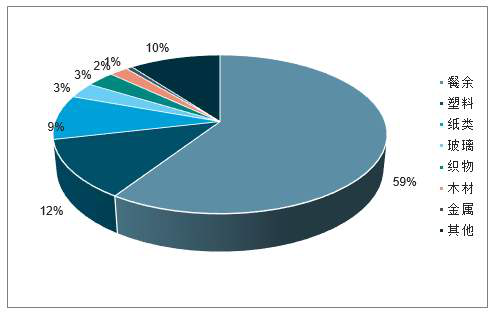Composition of municipal solid waste (MSW) is one of the key parameters directly affecting the selection of waste treatment methods and the design and planning of treatment facilities. It is a dependent variable affected by many factors, such as geographical environment, energy structure, economic development, living habits, living standards, climatic characteristics and waste recycling. According to China’s relevant standards, the composition of municipal solid waste is divided into four categories: organic matter, inorganic matter, recyclable matter and other garbage. Organic matter can be divided into plant waste and animal waste. For household waste, it mainly consists of kitchen waste such as vegetables, meat and aquatic products. Inorganic wastes, such as lime, brick, tile and ceramics, are of low recycling value and will not cause serious harm to the natural environment. The classification of recyclables mainly considers the technological requirements in the process of material utilization and resource regeneration after recycling. It can be divided into paper, plastics, rubber, textile, wood and bamboo, glass, metal and other types in order to facilitate the comprehensive utilization of waste products.
The results of dynamic statistics show that while the output of municipal solid waste in China is increasing rapidly, the composition of municipal solid waste has also changed greatly. Despite the unbalanced economic development in different regions, the composition and characteristics of municipal solid waste are very uneven. However, the composition of municipal solid waste shows a consistent trend in both southern and Northern cities, large and small cities. That is to say, the inorganic composition decreases significantly with the passage of time, while the perishable and recyclable materials do. Generally increasing, the proportion of combustibles is also increasing, which will have a greater impact on the development of municipal waste treatment and disposal technology in the future. Its characteristics can be summarized as follows:
(1) There are obvious differences in the composition of garbage between big cities and small and medium-sized cities. Organic matter accounted for 31%-36% of the total amount of municipal solid waste, inorganic matter accounted for 60%, waste accounted for 4%-6%, organic matter accounted for 20% of the total amount of municipal solid waste in small and medium-sized cities, inorganic matter accounted for 75%, and the proportion of waste was lower.
(2) In terms of geographic environmental impact, the proportion of organic matter and combustible matter in urban garbage in southern China is higher than that in northern China. The main reasons are as follows: the proportion of coal burning and the utilization rate of living energy in northern cities are higher or longer than those in southern cities due to climate differences, so the proportion of ash and residue in garbage increases and the proportion of organic matter decreases relatively; the difference of dietary structure leads to the consumption of fruits and vegetables and the consumption period of fruits and vegetables in southern cities are larger or longer than those in northern cities. In terms of the overall economic level, the southern municipal solid waste is higher than the northern municipal solid waste, so the proportion of paper, plastics, rubber and other combustibles and recyclables in the garbage is relatively large. Relevant analysis shows that the composition of municipal solid waste in small and medium-sized cities is closely related to the geographical environment. Organic matter in municipal solid waste in the North accounts for about 16.42%, and organic matter in municipal solid waste in the south is obviously higher than that in the north, 28.54%. However, for large cities, although their geographical environment and other basic conditions are different, because the consumption level of urban residents is relatively high, the organic content gap in urban garbage is relatively small. Therefore, with the development of economy, the development of the artificial environment of city will be more perfect, the influence of natural environment on the life of urban residents will be less and less, and the influence of natural environment on the composition of municipal solid waste will also be weakened.
(3) The proportion of organic and combustible substances in garbage in economically developed areas or cities is relatively large, whether in the South or in the north. For example, the contents of kitchen waste, paper, plastic and rubber in the economically developed large cities are higher. Take kitchen waste as an example: 70% in Shanghai, 63% in Guangzhou, 58% in Shenzhen, 52% in Nanjing and 50% in Tianjin. However, in small and medium-sized cities with low consumption level and energy gasification rate, the organic component of domestic waste only accounts for 22.48% of the total amount of garbage, and the inorganic component accounts for 65% of the total amount of garbage. The proportion of recyclable materials is very small.
(4) Fuel structure has a significant impact on the yield and composition of garbage. With the popularization of urban central heating and coal gasification, great changes have taken place in the structure of civil fuels, as well as in the composition of municipal solid waste. The main manifestation is the influence of inorganic substances in garbage, i. e. the amount of coal ash. For coal-fired areas, the proportion of coal ash and slag in refuse can reach as high as 70%~80%; for gas, the proportion of coal ash tends to zero theoretically, but because of the existence of ash and slag soil, its inorganic composition is about 30%. Relevant data show that the fuel structure affects the daily production of organic matter per capita to a certain extent, which also affects the composition of garbage.



